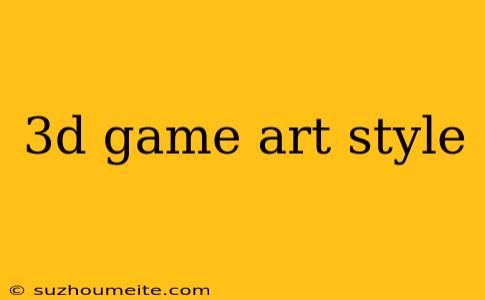3D Game Art Style: Exploring the Visual Possibilities
In the world of 3D game development, art style plays a crucial role in shaping the overall aesthetic and atmosphere of a game. From realistic to stylized, the art style of a game can significantly impact the player's experience and engagement. In this article, we'll delve into the various 3D game art styles, their characteristics, and the techniques used to achieve them.
Realistic Art Style
Realistic art styles aim to mimic real-world environments and characters as closely as possible. This style is often used in games that require immersion and authenticity, such as first-person shooters or open-world RPGs.
Characteristics:
- Highly detailed textures and models
- Accurate lighting and shading
- Realistic character animations and physics
Techniques:
- Advanced lighting techniques, such as global illumination and ambient occlusion
- High-poly modeling and detailed normal mapping
- Physically-based rendering (PBR) for realistic material appearances
Stylized Art Style
Stylized art styles deviate from realism, often incorporating exaggerated features, vibrant colors, and abstract shapes. This style is commonly used in games that want to create a unique and fantastical atmosphere, such as platformers or adventure games.
Characteristics:
- Vibrant, often unrealistic color palettes
- Exaggerated character designs and animations
- Simplified textures and models
Techniques:
- Cel-shading and toon shading for a cartoonish look
- Low-poly modeling and simplified normal mapping
- Creative use of materials and shaders to achieve stylized effects
Cartoonish Art Style
Cartoonish art styles take the stylization a step further, often featuring bold lines, bright colors, and comedic character designs. This style is commonly used in games that want to create a lighthearted and humorous atmosphere, such as party games or casual mobile games.
Characteristics:
- Bright, vibrant colors and bold lines
- Comedic character designs and animations
- Simplified textures and models
Techniques:
- Cel-shading and toon shading with bold outlines
- Low-poly modeling and simplified normal mapping
- Heavy use of particle effects and animations to enhance the comedic tone
Cell-Shaded Art Style
Cell-shaded art styles combine realistic models with stylized, comic-book-inspired shading and textures. This style is often used in games that want to create a unique, graphic novel-like atmosphere, such as action-adventure games or fighting games.
Characteristics:
- Realistic models with stylized, comic-book-inspired textures and shading
- Bold lines and vibrant colors
- Emphasis on dynamic action and movement
Techniques:
- Advanced lighting techniques, such as rim lighting and ambient occlusion
- High-poly modeling and detailed normal mapping
- Custom shaders and materials to achieve the cell-shaded look
Low-Poly Art Style
Low-poly art styles use simplified models and textures to create a retro or minimalist aesthetic. This style is often used in games that want to create a nostalgic or indie feel, such as puzzle games or retro-style platformers.
Characteristics:
- Simplified models and textures
- Limited color palettes and pixel art-inspired graphics
- Emphasis on gameplay and simplicity
Techniques:
- Low-poly modeling and simplified normal mapping
- Pixel art-inspired textures and graphics
- Minimal use of advanced lighting techniques and shaders
In conclusion, 3D game art styles are diverse and varied, each with its own unique characteristics and techniques. By understanding the different styles and their applications, game developers can create visually stunning and engaging experiences that draw players in and keep them invested.
